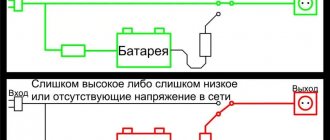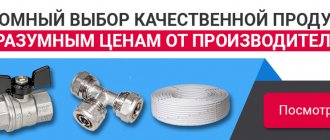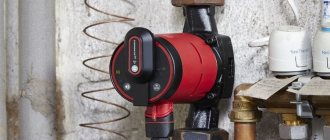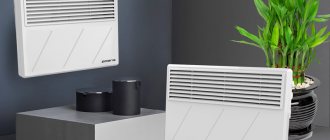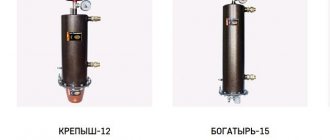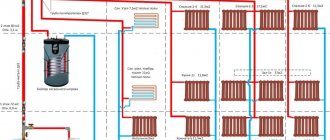A stabilizer for boiler equipment is necessary to protect pumps and automation units from power surges and clean them from frequency distortions. It is used in gardens, country houses, and rural houses where there is instability in the electrical network. The device protects precision equipment responsible for the operation of the heating system from damage. Selection indicators: pump or control unit power taking into account starting currents, error value, overall dimensions.
POWERMAN AVS 500 S – affordable price
Single-phase stabilizer for working with gas boiler equipment with a power of up to 200~300 watts. It is small in size and weight. Made in a wall-mounted version. Equipped with a European output socket. Stabilizes the input parameters of the electric current.
Built-in filters cut off extraneous frequency noise and remove interference. Visual control is carried out on a liquid crystal display. The current state of the structure is reflected by light indicators.
Pros:
- Compact, light weight, fulfills its functions.
- Peak load and short circuit protection.
- Inexpensive, easy to install and connect.
Minuses:
- The socket is at the bottom, slightly inconvenient.
- For some reason there is no second indicator.
Recommendations: 12 best gas boilers
13 best solid fuel boilers
14 best electric boilers
LENZ TECHNIC R500W – accuracy and price
Automated input voltage stabilization device. Used in private homes, medical institutions, office and administrative premises. Built-in protection mechanisms against overheating and overload during intensive work.
The stabilizer has low error and high accuracy of output parameters. It is possible to connect two consumers with a total power not exceeding 500 watts. It neutralizes a wide voltage range and has a 100% power factor.
Pros:
- Compact, accurate, low level of error.
- Bright color LCD screen. Easy connection.
- My two consumers are powered by a gas boiler and a circulation pump.
Minuses:
- Operation in 0.02 seconds, there are better indicators.
Rucelf BOILER-600 – application in dachas
The design is specially designed to work in tandem with heating equipment in conditions of unstable power grid indicators. Used in rural areas, places with constant voltage fluctuations.
Designed to work with gas boilers, heating equipment control units, circulation pumps, household and electronic appliances. Has a wide input voltage range. Does not distort the sine wave.
Pros:
- Clear operation, works well with a gas boiler.
- Quick installation and connection, affordable price.
- Quiet, durable body.
Minuses:
- Consumers do not note any shortcomings.
How to connect
Manufacturers of stabilizers clearly state in the instructions how to turn on the device. First of all, you need to prepare a workplace, which must be dry. Further, the installation takes place in such a way that there is an unobstructed approach to the device.
At the same time, it must be taken into account that the regulator is air cooled. For this reason, a lot of free volume in front of it will be required. Therefore, placing it in a sideboard or drawer is prohibited. And the last limitation is that the installation is placed away from fire-hazardous building materials.
A monophase device is connected via a standard socket. The plug with the adjusted network values is connected to the socket on the boiler body.
We recommend reading: Washing machine with sink included: selection and installation
Based on the above, it can be argued that a stabilizer is needed for the gas boiler to function correctly and not be damaged by failures in the power grid.
The specific conditions of the power supply and the power of the equipment being protected will determine which voltage stabilizer will best cope with its tasks.
DAEWOO DW-TM1kVA – quality and power
Single-phase wall-mounted voltage stabilization device. It is distinguished by high build quality and stable output indicators. The response time does not exceed 20 milliseconds. The total power allows you to connect two consumers, taking into account the magnitude of the starting currents.
Reliability of control is ensured by an electronic unit based on microprocessors. The stabilizer has a low level of its own noise. Provides protection against short circuit, overload and overheating.
Pros:
- High-quality assembly, nice design, powerful.
- Filters, short circuit protection. Doesn't make any noise at all when the voltage isn't floating.
- Bright and large display, easy wall mounting, connection of two consumers.
Minuses:
- The cord is terribly short, and you can’t hang it close to the boiler - it can heat up.
- Beautiful and poorly informative instructions.
Popular manufacturing brands
Voltage stabilizers are highly valued by users and are widely in demand . Therefore, many companies are engaged in their production, both in Russia and abroad. Among the most well-known manufacturers are the following companies:
Daewoo Power Products
A South Korean company that has located production facilities in China.
It is a well-known manufacturer of power and garden equipment . The company has been engaged in production activities for more than half a century, having accumulated considerable technological experience. Despite its advanced age, the company's potential is assessed as very high.
New devices, components and parts are constantly being developed . Devices are being created based on modern schematic solutions. Daewoo Power Products products are in demand on the market and are famous for their quality and operational reliability.
Wester
A trademark owned by a Russian company . Initially, it was a brand for the main types of products of the Impulse Group of Companies, but later it gained more independence.
Today, Wester has established strong contacts with manufacturers from Europe and the USA. There are partners in the UK, Austria, Italy, Germany, Switzerland. Users note the high quality and reliability of Wester products.
Calm
Shtil Group of Companies is a Russian manufacturer of power supply systems, stabilizers, and other electrical devices.
The company is a recognized leader among other manufacturers of specialized products. The group of companies has been awarded diplomas and awards from Russian ministries for the quality and efficiency of their devices. Users consider the company one of the most preferred manufacturers of electrical equipment, producing reliable and high-quality devices.
LogicPower
It is a subsidiary of the Chinese company Logicfox. The brand was created specifically for the production of stabilizers, surge protectors, uninterruptible power supplies and other electronics.
The company's products are in high demand and are positively assessed by experts and specialists . The high quality and efficiency of the devices, reliability and durability of the electronics of this company are noted.
To maintain equipment in good condition, the company creates an extensive network of service centers, which allows users not to worry about repair and maintenance of devices.
Powercom
A Chinese company whose production facilities are located in Taiwan. The company began its activities a little over 30 years ago with the manufacture of uninterruptible power supplies.
It is this company that takes the lead in the development of PWM modulation devices . Today the company produces a wide range of products, of which voltage stabilizers account for only a small part. The company's products are distinguished by their quality, resistance to stress, and durability.
The list of manufacturers can be continued for a long time.
When choosing, you should take into account not so much the name and authority of the manufacturer, but the characteristics of a particular model . This approach will allow you to avoid mistakes and purchase an effective and efficient stabilizer.
RUCELF BOILER-1200 – protection of boiler units
Single-phase stabilizer for reliable provision of boiler heating equipment with stabilized voltage. It is implemented in a wall-mounted version, which allows you to save space and make more efficient use of the room area.
Levels out voltage surges and eliminates impulse noise. Works over a wide input range. It has a high motor life, the internal components are enclosed in a durable and rigid steel body.
Pros:
- Performs basic functions successfully and works in a basement environment.
- Powerful – boiler and circulation boiler connected.
- Durable, rigid case, small in size, mounted on the wall.
Minuses:
- No input fuse.
Energy VOLTRON - 1,000 5% E0101-0154 - power and accuracy
Wall mounted stabilizer. Levels out input distortions of network electricity. It is distinguished by high accuracy and small error coefficient.
Works in tandem with computer and household appliances, heating equipment, control units from the “smart home” series.
It is used in private homes, medical institutions and laboratories, and office premises. Reaction time is less than 10 milliseconds. Works outdoors in any weather.
Pros:
- High-quality assembly, beautiful design, precision.
- Powerful device, good output parameters, small error.
- Small size, LED display.
Minuses:
- Only one output socket.
Availability of protection and restart function
When choosing a voltage stabilizer for a gas boiler, you should pay attention to the protection options. Very cheap devices may not have them, which can lead to failure of the stabilizer itself.
1. An important function is to turn off the device when overloaded. This happens when it is operating at its capacity limit due to the incoming voltage being too weak. To prevent the turns of the transformer or the board from burning out, the device turns itself off.
2. The same process occurs in the case of too high surges, which the stabilizer is not able to reduce to the outgoing 220 V. In order not to cause harm to the gas boiler, the current source is turned off.
3. Depending on the installation location, loads and operating area, the stabilizing device may also experience temperature effects. It would be good if, in case of significant overheating, it could interrupt the line itself until it cools down.
4. If there are protection functions, the ability to restart is also useful, eliminating various inconveniences. For example, when there was a significant voltage drop, the stabilizer turned off, which caused the gas boiler to stop. The owners were at work at the time. When turned off, the device continues to monitor network parameters, and when they are normalized to values that the device can handle within its capabilities, the power is restored.
Once connected, the boiler starts up and the owners return to their heated home. Otherwise, when there is no restart function, the whole house has cooled down when they arrive, although the voltage has long been normal. And if this happened during the winter holidays, when the family was on a trip, then the system may completely collapse.
The restart function can be set with a delay to prevent frequent boiler starts when the input value is unstable and balances at a border level.
Without the restart option, turning on the stabilizer and boiler will always require manual mode with human participation. Pay attention to the presence of a restart when choosing a voltage stabilizer.
Additional features
When choosing a voltage stabilizer for a gas boiler, you need to take into account other additional features that are not key, but will contribute to more convenient operation.
Design
Stabilizers for gas boilers can be in sizes from 200x300x70 mm to 450x500x300 mm. The dimensions of the housing depend on the technology (electromechanical, relay or electronic), as well as the size of the transformer and the number of relays, which determines the smoothness of adjustment and the power of the device. To place it in your home, you should look for compact models that can be neatly integrated into the interior, and maybe even hidden in a small furniture drawer. If the boiler is installed in a separate boiler room, then the size of the device does not matter there.
Stabilizers can be wall-mounted or floor-mounted. The first type makes it easier to monitor the indicators because it can be placed at eye level and a short glance while passing by is enough to see that everything is in order.
When the unit is placed on the floor, you may have to lean towards it. But this will not need to be done so often, so the choice is up to the owners.
When installed inside an apartment or house, wall-mounted models are practical, since they are easier to hide by surrounding them with shelves. There are also rack stabilizers, but their power far exceeds the needs of the boiler and pump, so there is no point in cluttering the corner of the room with a 19-inch vertical structure.
The design also includes the number of output connectors. Although the main consumer is a gas boiler, if there is a need to protect other electronic devices in the house from low voltage or surges, then you should choose a stabilizer with a power reserve and several sockets (3-4), which will allow you to connect another household appliances.
Indication
A stabilizer for a gas boiler can display the current voltage in volts at the input to and output from the device. For this purpose, the housing can be equipped with an LED display, pointer sensors or diode indication.
Stabilizers with LED display. Bright numbers are clearly visible in the daytime and at night, allowing you to instantly assess the situation at a glance. This is the most practical and modern option.
Voltmeter dial gauges. This is an analog legacy solution. This version does not have a backlight and in the dark you need to use a flashlight. But the accuracy of the readings remains high and helps to monitor the voltage.
Diode indication. In this case, users do not know the number of incoming volts and the level of their correction, but only see from the green indicator that the voltage is normal, and from the yellow indicator that stabilization is occurring (which means it is now too low or too high). When the red diode lights up, this indicates that the protection has tripped. Used on budget products, not very informative, but quite acceptable.
Operating temperature range
Installing a voltage stabilizer for a gas boiler is meant to be installed inside the building, so few people worry about the range of operating temperatures. But if installation is planned in a boiler room, which is a separate extension, then you should make sure that the device can withstand a temperature drop of up to +5 degrees and can operate correctly. It is also not recommended to mount it too close to the boiler and it is important to ensure that air can circulate freely around its body.
Bastion Teplocom ST-555 – super compact design
Small-sized voltage stabilization device. Levels out differences in input parameters of the electrical network. The model is specially designed to protect the heating system and individual components, including gas boilers. Has a remote socket on a flexible cable.
The stabilizer is designed for use in basement conditions with high humidity. Provides protection against lightning strikes.
Pros:
- Super small size, easy to install, lightweight.
- Completely fulfills its duties and is quite accurate.
- Bright LED indication, replaces the night light at night.
Minuses:
- Loud, very good clicks when working.
- The output voltage fluctuates and there is instability in operation.
In what case is it advisable to use a UPS instead of a stabilizer?
In addition to voltage stabilizers, there are also uninterruptible power supplies (UPS), which provide a constant volt value and can provide voltage to boiler equipment. Their difference lies in the presence of batteries that provide backup current even when the power in the house is completely turned off. The duration of power supply depends on the battery capacity, and the latter is directly related to the size of the equipment and cost.
It is not advisable to buy an IPB when there are no long power outages. If in an apartment building or village the voltage sometimes disappears (breaks in the line, drop below 100 V from user loads), the stabilizer will turn off the boiler and wait for the power to be restored. Since the heating has a large temperature reserve, the system will not shrink after 5-6 hours of inactivity, even in the most severe frosts. As soon as the voltage level is restored to the minimum allowable according to the stabilizer’s passport, it will pass it through and the boiler automation will start working again.
But if power outages occur for a long time (the light went out in the evening and appeared only the next day at lunch), and this happens once a month, then you should think about purchasing an UPS. Using batteries, the device will be able to provide power to the boiler and pump, which will prevent the coolant from cooling down.
Its principle of operation is to accumulate energy in batteries while there is voltage in the network, and release current to consumers in the event of a general shutdown. The transition from external voltage to internal voltage occurs instantly, so the equipment continues to work. The disadvantages of the UPS include more complex maintenance, increased housing size, and high cost.
UPS types
Uninterruptible power supplies are structurally divided into two types:
UPS with built-in battery. They have a small reserve due to the low battery capacity. Designed to maintain the functionality of the boiler electronics, and possibly equipment alarms (low-flow networks).
UPS connected to external batteries. This is a more advanced type of equipment that is capable of powering the boiler, pumps, and ensuring the operation of solenoid valves and other actuators. With their help, you can survive long blackouts without any consequences for the indoor microclimate.
UPS architecture type
Equipment with batteries is divided into three types according to their design architecture:
- Offline. They operate without a built-in stabilizer, so as soon as the network indicators become unacceptable, they switch to battery operation. If the input current parameters change frequently, the battery will be used regularly and will quickly discharge.
- Online. Has an increased number of batteries and produces double current conversion. The battery is constantly recharged, and the boiler receives voltage from the battery, converting 36 V DC to 220 V AC. Optimally suitable for boiler equipment, but expensive.
- Linear interactive. At the same time, the battery is recharged and voltage is supplied to the boiler, leveling the indicator to 220 V. It is distinguished by sufficient accuracy of the output voltage and an average price.
Comparison of voltage stabilizers and UPS
| Stabilizer | UPS | |||||||
| In what case is it advisable to use. | During short-term power surges and rare power outages. | With frequent power outages for long periods. | ||||||
| Principle of operation. | Eliminates short-term power surges and stabilizes voltage. | As long as there is electricity, the batteries are charged; during a power outage, the batteries are a source of electricity. | ||||||
| Service. | Simple. | More complicated due to the presence of batteries. | ||||||
| Device size. | The device is compact. | The dimensions of the device are large. | ||||||
| Price. | Lower than UPS. | High. | ||||||
To summarize, we can highlight the main points: a voltage stabilizer is essential to protect the gas boiler; It is important to calculate its power with a reserve according to the formula, select a speed of 5-10 ms. The protection and restart functions are important. For prolonged power outages, it is better to choose a UPS with online architecture.
If you notice an error, a non-working video or link, please select a piece of text and press Ctrl+Enter .
0
Energy ARS-1500 E0101-0109 – optimal for gas boilers
Single-phase stabilizer with high efficiency, up to 98%. It has a small error, no more than 4%. The model is specially designed for use with various heating equipment based on solid, liquid or gaseous fuels.
It has sufficient power to work with the control unit and protect against power surges of the circulation pump. The magnitude of starting currents is taken into account. The response time does not exceed 10 milliseconds.
Pros:
- Power combined with good accuracy.
- Optimal for a gas boiler, connected together with a pump.
- Vertical design, mounted to the wall.
Minuses:
- Massive, difficult to attach to plasterboard walls.
What characteristics of the stabilizer need to be taken into account?
To understand how to choose a voltage stabilizer for a gas boiler, you need to understand its key parameters and their effect on the operation of the heating device. This will help you choose the device that is most suitable for specific operating conditions.
Phasing
Most apartment buildings and private houses are connected to a single-phase 220 V network with a frequency of 50 Hz. To use voltage stabilizers in them, it is advisable to buy single-phase models. There are houses with three-phase input, but each line is divided and produces 220 V. This contributes to a more even distribution of the load and allows the use of the same single-phase stabilizers.
For enterprises and industries where large gas boilers with high power are installed, three-phase 380 V stabilizers will be required. The second option would be to install single-phase equipment, one for each phase, which will be cheaper in total, but will take longer to connect.
Input voltage range and output voltage accuracy
Voltage stabilizers for gas boilers must ensure that the current from the network is brought to the optimal 220 V. Depending on the scale of the voltage drop, stabilizers are also produced with different input current ranges. To find out what parameters to look for a device with, you need to do a little research.
To do this, you need a voltmeter (pointer or digital multitester). The electronic device must be set to an alternating current value with an upper limit of more than 500 V. Measurements should be carried out at different times of the day to see how the indicators change depending on the load on the network. It is optimal to observe during the week and measure the volts at: 6:00, 9:00, 12:00, 15:00, 18:00, 21:00, 24:00 hours. It’s good to have a notebook to record the data received. At the end of the experiment, you can add 10-15 V in each direction to create a small margin.
If testing shows the limits of 180-240 V, then it is with such data that you should look for a voltage stabilizer. Sometimes, outside the city, there may be differences in the network from 140 to 270 V, which will require a different model.
The output voltage of the stabilizer should correspond as much as possible to the performance of the gas boiler. In most cases this is 220 V + -10%. To avoid shutdowns due to lack of power, it is better to choose devices with an output voltage accuracy of +-5%. Then it will completely fit into the data required by the manufacturer and contribute to uninterrupted operation.
Power
One of the most important criteria for choosing a voltage stabilizer for a gas boiler is power. First you need to find out what indicator is written in the equipment passport. Boilers have two values: maximum useful thermal power (varies from 6000 to 24000 kW) and power consumption (100-200 W or 0.1-0.2 kW). But during boiler startup, this value may increase by several seconds, so the stabilizer indicator should exceed the boiler data. How long? This will become clear after we learn the remaining components of the calculation.
The second component is VA. These are volt-amperes, which indicate the power of stabilizers. They differ from kW (kilowatts) or W (watts) in that they represent total power, while the latter only represent useful power. As a result, a device with a power of 500 VA will have a rating of 350 W.
The power of the stabilizer must cover not only the consumption of the boiler, but also the associated equipment installed inside or in parallel. This could be a circulation pump, which has its own power rating.
In order for the voltage stabilizer to fully correspond to the boiler and pump, its indicator must take into account the increasing starting currents and have a margin of 30% from the maximum power of the sum of all devices.
Now all this can be fixed by the formula: (boiler power W + pump power W * 3) * 1.3 = stabilizer power VA. For example: boiler - 150 W, and pump - 70 W. We get: (150 W+70 W*3)*1.3 = 468 VA.
But it is also important to take into account voltage sag. If the input current drops, then the ability of the stabilizer to increase it also drops. For example, if there is 170 V in the outlet, the efficiency of the stabilizer will decrease by 80% of the rated power, and at 130 V it will work only at 50% of the declared value. Therefore, the rated power of the stabilizer must be multiplied by the percentage drop and divided by 100.
Let's calculate: if the network is 170 V, which is 80%, then with a stabilization device of 500 VA it will work as if it were 400 VA. For the above example, a 150 W boiler and a 70 W pump, taking into account the 170 V drawdown, you need to look for a 600 VA stabilizer.
Voltage stabilization performance
This parameter is indicated by two units of measurement:
- response speed - measured in volts per second (V/s) and reports the period taken to restore normal output voltage in the event of significant fluctuations in the input;
- response time - indicated by the milliseconds it takes for the device to react to change the network signal.
The higher the speed and the shorter the response time, the better the gas boiler is protected during surges, both in one direction and the other. The highest quality voltage stabilizers have a first rating of 100 V/s and higher. This allows the protective equipment to respond almost instantly. Data of 10-20 V/s indicate some delay, sufficient for short-term incorrect operation of the boiler.
The response time is considered good from 5 ms or less. 10ms will be quite acceptable, and 20ms will be satisfactory. Large values already imply some risk. Inverter devices use double current conversion, so they do not have a speed parameter.
Output voltage form
Alternating current is indicated by a wavy line due to its changing frequency. On the scale it has the shape of a sine wave. In order for a gas boiler to operate stably and correctly, the voltage must be as close as possible to an ideal sinusoid. A clean output signal will not create errors or malfunctions in the electronics.
Shtil R 600T – protection in rural homes
A reliable device for working with high-precision electronic equipment, including microprocessor control units for heating boilers. Has low error, wide input voltage range.
An optimized control algorithm allows you to disconnect consumers during sudden peak loads. There is a mechanism for automatic activation when the extreme values decrease. Two European standard sockets are built-in for connecting protected equipment.
Pros:
- Stable operation, optimal accuracy.
- Small dimensions, wall mounting kit.
- Large input voltage swing.
Minuses:
- Sometimes the lighting flickers, but does not affect the operation of the boiler.
Calm R 800T – high reliability
Wall-mounted single-phase AC voltage stabilizer. Designed to work with heating equipment and heating boilers. Has built-in frequency filters to correct input distortion.
Equipped with LED indication, two European sockets are built-in for connecting to consumers. An electronic protection system and a special algorithm for operating in normal mode and peak loads are used.
Pros:
- High-quality assembly, nothing superfluous, good power.
- Design, informative display.
- Unpretentious, reliable, stable output parameters.
Minuses:
- The display is missing.
- Possibly high price.
